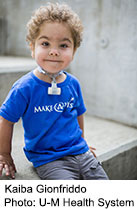Flexible implant adapts with child’s growth, researchers say
THURSDAY, April 30, 2015 (HealthDay News) — An implant created with a three-dimensional (3-D) printer has demonstrated success in three patients, from 3 to 16 months old, with tracheobronchomalacia, according to trial results published in the April 29 issue of Science Translational Medicine.
The researchers used computed tomography (CT) scans of the children’s airways to create computer models from which they tailored each device to each child’s specific anatomy. Airway splints were made of hollow, porous tubes shaped like the letter “C,” study coauthor Scott Hollister, Ph.D., a professor of biomedical and mechanical engineering at the University of Michigan in Ann Arbor, told HealthDay. Surgeons sutured the splints around the affected airways, essentially propping open the passages. As the children grew, the thin splints flexed and allowed their airways to grow while staying open. The splints are made of a biomaterial that will dissolve as the airway becomes strong enough to stand open on its own.
Following the surgery, doctors tracked progress using CT and magnetic resonance imaging scans. None of the devices caused any complications, and the three children now are home with their families.
Study coauthor Robert Morrison, M.D., also of the University of Michigan, told HealthDay that 3-D printing also can be used to craft precision devices that will adapt to changes in the body. Because of this, they can treat a wide variety of illnesses — “anything where you’re expecting a significant increase in either organ or anatomical structure change,” he said. “You can really create anything that you could imagine to eventually become a medical device.”
Copyright © 2015 HealthDay. All rights reserved.








